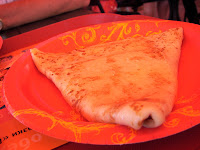New Year's Eve is kind of a big deal* for immigrants from the former Soviet Union. The New York Times explained it so in 1985:
The secular attributes of Christmas-the lighted tree, the gifts, the cards, Santa Claus, street decorations - have been assigned by the Soviet state to New Year's, and it is then, starting on Dec. 31, that Russians will try to do justice by both New Year's and Christmas, combining the midnight drinking of the former and the gift-giving and family cheer of the latter in ample measures.
The idea of the hybrid holiday is usually attributed to Stalin. In the first years after the revolution, the Bolsheviks apparently tried to stamp out the celebration of Christmas altogether, targeting the traditionaldecorated fir trees as a particularly glaring symbol of reactionary rituals for which there was no place in the new atheist society.
The people, however, proved reluctant to part with a cherished winter holiday. So in 1935, the story goes, Stalin did what the Kremlin has done so many times since with sticky customs - he co-opted it. He lifted the ban on Christmas trees,except that he said they were New Year's trees, and he declared that New Year's, Novyi God, was to be a national family holiday - a sort of surrogate Christmas stripped of any Christian meaning.
The people, it must be acknowledged, took to the idea. New Year's has evolved into probably the most popular of official Soviet holidays...the streets are hung with bright lights, decorated with brightly decorated trees, and the stern Lenins and Marxs make way for Grandpa Frost, the Russian Santa Claus. The Soviet New Year's, in fact, has become pretty much what Christmas has become in the secular Western world - a day for families to gather and share gifts and goodies under a tree, brightly lit and trimmed with homemade decorations.
I've never had a good American-style New Year's. You know, the kind where you dress up and go out and ring in midnight with a horde of friends. New Year's Eve has stayed a family holiday for me. This year again, I hope to report on delish zakuski (appetizers) that are typically served on Dec. 31.
Whatever your New Year's Eve traditions, I wish you a good one.
*At least New Year's used to be the big holiday--I wonder if traditions have changed at all in the past 17 years. Anyone care to update me?
















































